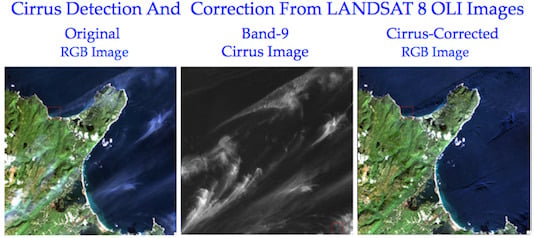Removal of Thin Cirrus Scattering Effects in Landsat 8 OLI Images Using the Cirrus Detecting Channel
Abstract
:1. Introduction
2. Materials and Methods
2.1. A Dark Ocean Scene
2.2. A Mixed Ocean and Land Scene
2.3. A Summary of the Empirical Cirrus Correction Procedures
- converting the measured radiances (L) into apparent reflectances (ρ*) using Equation (1);
- estimating the slope, SB, from the scatter plot (also see Figure 4c);
- calculating the cirrus reflectance of the given band, ρc(B), which is equal to ρ*(cirrus)/SB;
- subtracting out the cirrus reflectance, ρc(B), from the measured apparent reflectance, ρ*(B), for removing the cirrus scattering effect in band B.
3. Results
3.1. Eastern Canada
3.2. Eastern U.S.
3.3. Baltic Sea
4. Discussion
5. Conclusions
Acknowledgments
Author Contributions
Conflicts of Interest
References
- Green, R.O.; Eastwood, M.L.; Sarture, C.M.; Chrien, T.G.; Aronsson, M.; Chippendale, B.J.; Faust, J.A.; Parvi, B.E.; Chovit, C.J.; Solis, M.; et al. Imaging Spectrometry and the Airborne Visible/Infrared Imaging Spectrometer (AVIRIS). Remote Sens. Environ. 1998, 65, 227–248. [Google Scholar] [CrossRef]
- Vane, G.; Green, R.O.; Chrien, T.G.; Enmark, H.T.; Hansen, E.G.; Porter, W.M. The Airborne Visible Infrared Imaging Spectrometer. Remote Sens. Environ. 1993, 44, 127–143. [Google Scholar] [CrossRef]
- Gao, B.-C.; Goetz, A.F.H.; Wiscombe, W.J. Cirrus Cloud Detection from Airborne Imaging Spectrometer Data Using the 1.38 µm Water Vapor Band. Geophys. Res. Lett. 1993, 20, 301–304. [Google Scholar] [CrossRef]
- Salomonson, V.V.; Barnes, W.L.; Maymon, P.W.; Montgomery, H.E.; Ostrow, H. MODIS: Advanced Facility Instrument for Studies of the Earth as a System. IEEE Trans. Geosci. Remote Sens. 1989, 27, 145–153. [Google Scholar] [CrossRef]
- King, M.D.; Menzel, W.P.; Kaufman, Y.J.; Tanré, D.; Gao, B.-C.; Platnick, S.; Ackerman, S.A.; Remer, L.A.; Pincus, R.; Hubanks, P.A. Cloud and Aerosol Properties, Precipitable Water, and Profiles of Temperature and Humidity from MODIS. IEEE Trans. Geosci. Remote Sens. 2003, 41, 442–458. [Google Scholar] [CrossRef]
- Murphy, R.; Guenther, B.; Ip, J.; Jackson, J.; Olenijczak, D.; Iisager, B.; Hutchison, K. Update on the Algorithmic Basis and Predicted Performance of Selected VIIRS Environmental Data Records. In Proceedings of the 2006 IEEE International Geoscience and Remote Sensing Symposium (IGARSS), Denver, Colorado, USA, 31 July–4 August 2006; pp. 266–269. [Google Scholar]
- Drusch, M.; Del Bello, U.; Carlier, S.; Colin, O.; Fernandez, V.; Gascon, F.; Hoerschb, B.; Isolaa, C.; Laberintia, P.; Martimort, P.; et al. Sentinel-2: ESA’s Optical High-Resolution Mission for GMES Operational Services. Remote Sens. Environ. 2012, 120, 25–36. [Google Scholar] [CrossRef]
- Storey, J.; Choate, M.; Lee, K. Landsat 8 Operational Land Imager on-orbit Geometric Calibration and Performance. Remote Sens. 2014, 6, 11127–11152. [Google Scholar] [CrossRef]
- Gao, B.-C.; Kaufman, Y.J. Selection of the 1.375-µm MODIS Channel for Remote Sensing of Cirrus Clouds and Stratospheric Aerosols from Space. J. Atm. Sci. 1995, 52, 4231–4237. [Google Scholar] [CrossRef]
- Zhu, Z.; Wang, S.; Woodcock, C.E. Improvement and Expansion of the Fmask Algorithm: Cloud, Cloud Shadow, and Snow Detection for Landsats 4-7, 8, and Sentinel 2 Images. Remote Sens. Environ. 2015, 159, 269–277. [Google Scholar] [CrossRef]
- Xu, M.; Jia, X.; Pickering, M. Automatic Cloud Removal for Landsat 8 OLI Images Using Cirrus Band. In Proceedings of the 2014 IEEE International Geoscience and Remote Sensing Symposium (IGARSS 2014), Quebec City, Quebec, Canada, 13–18 July 2014; pp. 2511–2514. [Google Scholar]
- Shen, Y.; Wang, Y.; Lv, H.; Qian, J. Removal of Thin Clouds in Landsat-8 OLI Data with Independent Component Analysis. Remote Sens. 2015, 7, 11481–11500. [Google Scholar] [CrossRef]
- Gao, B.-C.; Yang, P.; Han, W.; Li, R.-R.; Wiscombe, W.J. An Algorithm Using Visible and 1.38-micron Channels to Retrieve Cirrus Cloud Reflectances from Aircraft and Satellite Data. IEEE Trans. Geosci. Remote Sens. 2002, 40, 1659–1668. [Google Scholar]
- Gao, B.-C.; Kaufman, Y.J.; Han, W.; Wiscombe, W.J. Correction of Thin Cirrus Path Radiance in the 0.4–1.0 µm Spectral Region Using the Sensitive 1.375-µm Cirrus Detecting Channel. J. Geophys. Res. 1998, 103, 32169–32176. [Google Scholar] [CrossRef]
- Knight, E.J.; Kvaran, G. Landsat-8 Operational Land Imager Design, Characterization and Performance. Remote Sens. 2014, 6, 10286–10305. [Google Scholar] [CrossRef]
- Vermote, E.; Justice, C.; Claverie, M.; Franch, N. Preliminary Analysis of the Performance of the Landsat 8/OLI Land Surface Reflectance Product. Remote Sens. Environ. 2016, 185, 46–56. [Google Scholar] [CrossRef]
- Gao, B.-C.; Li, R.-R. Quantitative Improvement in the Estimates of NDVI Values from Remotely Sensed Data by Correcting Thin Cirrus Scattering Effects. Remote Sens. Environ. 2000, 74, 494–502. [Google Scholar] [CrossRef]









| Bands | Wavelength (μm) | Resolution (m) |
|---|---|---|
| Band 1–Ultra Blue | 0.43–0.45 | 30 |
| Band 2–Blue | 0.45–0.51 | 30 |
| Band 3–Green | 0.53–0.59 | 30 |
| Band 4–Red | 0.64–0.67 | 30 |
| Band 5–Near Infrared (NIR) | 0.85–0.88 | 30 |
| Band 6–Shortwave Infrared (SWIR) 1 | 1.57–1.65 | 30 |
| Band 7–Shortwave Infrared (SWIR) 2 | 2.11–2.29 | 30 |
| Band 8–Panchromatic | 0.50–0.68 | 30 |
| Band 9–Cirrus | 1.36–1.39 | 30 |
© 2017 by the authors. Licensee MDPI, Basel, Switzerland. This article is an open access article distributed under the terms and conditions of the Creative Commons Attribution (CC BY) license (http://creativecommons.org/licenses/by/4.0/).
Share and Cite
Gao, B.-C.; Li, R.-R. Removal of Thin Cirrus Scattering Effects in Landsat 8 OLI Images Using the Cirrus Detecting Channel. Remote Sens. 2017, 9, 834. https://doi.org/10.3390/rs9080834
Gao B-C, Li R-R. Removal of Thin Cirrus Scattering Effects in Landsat 8 OLI Images Using the Cirrus Detecting Channel. Remote Sensing. 2017; 9(8):834. https://doi.org/10.3390/rs9080834
Chicago/Turabian StyleGao, Bo-Cai, and Rong-Rong Li. 2017. "Removal of Thin Cirrus Scattering Effects in Landsat 8 OLI Images Using the Cirrus Detecting Channel" Remote Sensing 9, no. 8: 834. https://doi.org/10.3390/rs9080834
APA StyleGao, B. -C., & Li, R. -R. (2017). Removal of Thin Cirrus Scattering Effects in Landsat 8 OLI Images Using the Cirrus Detecting Channel. Remote Sensing, 9(8), 834. https://doi.org/10.3390/rs9080834






